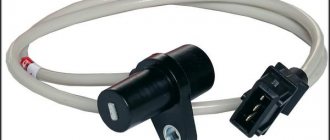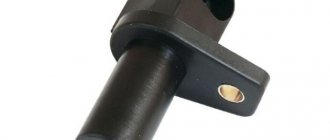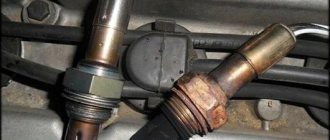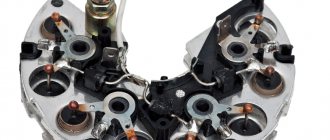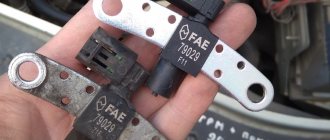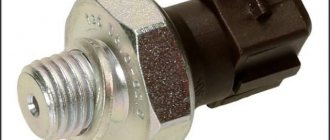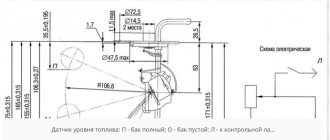Welcome, friends, to the DIY car repair website. Modern generation engines are characterized by good power and fuel economy.
The engine settings are controlled by a computer. Indicators of its operation are taken from various sensors.
Crankshaft position sensor VAZ 2110
Of these, only one can stop the engine if it breaks down. This is the crankshaft position sensor (CPS). Its main task in the VAZ 2110 car is to synchronize the fuel supply and ignition systems.
When this node breaks down, this synchronization is disrupted, causing the entire system to fail. No spark, no fuel supply. The power unit may not behave adequately and eventually stops anyway.
The operating principle of the crankshaft position sensor is that it takes readings about the rotation speed of the CV and its position using magnetic pulses. VAZ engines have slightly different PCV sensors, so you only need to change them to a similar one. We also recommend reading how to check the throttle position sensor.
If the sensor breaks down, you can check it with just one screwdriver and a multimeter. The first sign of a breakdown of the VAZ 2110 crankshaft position sensor is a large drop in power, as well as when the “Check Engine” light is on.
Here is a list of other signs of DPKV failure:
- Unstable idle.
- Increasing and decreasing engine speed.
- Drop in traction.
- Engine detonation, shooting in the intake or exhaust manifold.
- The motor does not start.
It is located in a not very convenient place on the engine; getting to it requires some time. Its location is on the oil pump cover, near the generator pulley.
How to check the crankshaft position sensor of a VAZ 2110
How to check the DPKV VAZ 2110 and make sure that it is faulty? There are a couple of options for sensor failure. But we can consider only two of them, the most common.
In any case, you need to remove it using a ten key. Before removing, we place marks on the sensor and the crankcase to fix its original position.
If there is no external or other damage to the DPKV, it is checked using other instruments. Read how to check the idle speed sensor here.
One more note when dismantling - it is necessary to measure the distance between the sensor and the sync disk. They should have a gap of 0.6-1.5 millimeters.
The first way to check is with an ohmmeter. You need to measure the winding resistance. The manufacturer specifies a number of 550 - 750 Ohms.
But they may be slightly different. If there are significant deviations in the readings, it is necessary to replace the VAZ 2110 DPKV with a similar one.
The design of the DPKV is very simple and it rarely fails, the main reasons being contamination, mechanical damage, or simply being defective.
In the second method, you also need to get a voltmeter, an inductance meter and a transformer. We measure the resistance as described in the previous method at room temperature.
Next we measure the inductance, it should be 200-4000 millihenry (mH). Using a megger, you need to measure the resistance with the power supply of the DPKV winding of 500 volts. The readings should not be more than 20 Mohm.
When replacing the sensor yourself, do not forget about its original position. And maintain the distance between the timing disc and the new crankshaft position sensor.
The torque to tighten the bolts is 8 - 12 N*m. Replacement should be carried out only if you are convinced that this unit is faulty. A new sensor may cause the engine to not operate properly; it is usually checked before installation as well.
So what kind of Sensor is this? Now let's try to figure it out.
The crankshaft position sensor (CPS) provides the ECU (electronic engine control unit) with information about the angular position of the crankshaft and the moment the pistons of the 1st and 4th cylinders pass TDC. If the sensor malfunctions, problems with engine operation occur. Let's consider the appointment, testing and replacement of DPKV.
What does the crankshaft sensor do?
DPKV synchronizes the phases of fuel injection and pulse supply to ignite the combustible mixture in the combustion chamber. In other words, based on its readings, the controller determines when and into which cylinder the fuel mixture should be supplied.
The sensor is of the inductive type and reacts to the passage of the teeth of the drive disk on the generator drive pulley near its core. The teeth are located on the disk at 6° intervals. To synchronize with TDC, two teeth out of 60 are cut off, forming a cavity. When a depression passes by the sensor, a so-called “reference” synchronization pulse is generated in it.
Checking the DPKV for serviceability
To verify the suspicion of a breakdown of the crankshaft sensor, the two most likely cases of its malfunction are considered. In both of these cases, you will need to dismantle the device using a ten-threaded wrench. Before the operation, marks are drawn on the crankcase and the sensor itself, which will later help to tighten the device to the initial angle of rotation.
Also, the motorist should not forget to measure the clearance between the synchro disk and the sensor before dismantling, which cannot go beyond the size of 0.6-1.5 mm. If there are no mechanical damage such as scratches, dents, or damage to the material structure, the sensor is checked using other measuring instruments:
- checking with an ohmmeter. In this case, it is necessary to measure the resistance of the sensor winding. Since the standard value of this indicator, set by the manufacturer, ranges from 550 to 750 Ohms, going beyond the specified limits indicates the malfunction of this device, which is important for the correct operation of the car - which means it is faulty. It is worth noting here that the manufacturer still allows a slight discrepancy in resistance with the nameplate values, but in any case they must correspond to the data specified in the machine’s operating instructions;
- checking with a voltmeter, inductance meter and transformer. This method is more complicated, but more effective - the resistance is measured with the same ohmmeter, after which the inductance is checked (should be from 200 to 4000 millihenry), with a sensor winding voltage of 500 Volts. Next, you need to measure the resistance with a megger and make sure that it does not exceed 20 MOhm.
If the sensor still does not pass these tests, it must be replaced. During this procedure, it is necessary not to forget about the distance between it and the synchronization disk regulated by the manufacturer, as well as alignment with the marks on the crankcase that were made on the previous device. Before installing a new sensor, be sure to check it, since even if all installation procedures are followed correctly, it may not work properly.
A modern car consists of many parts, each of which performs its own important function. Information about the condition of the engine and other components is transmitted by various sensors, but the VAZ 2110 crankshaft sensor performs work that is unusual for these devices.
Purpose of the crankshaft position sensor VAZ 2110
If the 9th or 10th series refuses to start, any driver immediately begins to check the power and ignition system, and when it comes to contacting a car service center, they say that the DPKV has failed (this is what the abbreviation for the full name of the sensor looks like). The bewilderment of car owners is dispelled when they find out that this is the only sensor without which the engine will not work.
The crankshaft sensor of the VAZ 2110, as well as on many other cars, does not perform a monitoring function, but synchronizes the phases and supplies the pulse to ignite the combustible mixture in the combustion chamber. Obviously, removing such an important attribute from the design makes it impossible for all systems to work harmoniously.
In its operation, the sensor uses the principle of electromagnetic induction, and reads the necessary “information” from the drive toothed pulley, in the immediate vicinity of which it is installed.
Crankshaft sensor VAZ 2110 - malfunctions and their diagnosis
Considering that the role of the DPKV in the operation of the engine is very significant, in the event of its malfunction, a variety of “surprises” can be expected. A completely failed sensor will definitely prevent the engine from starting. Other manifestations of sensor problems include:
- unstable operation of the engine at idle;
- power reduction;
- increase and decrease in the number of crankshaft revolutions (spontaneously);
- detonation with increasing load;
- launch intermittently.
For a device such as the VAZ 2110 crankshaft sensor, faults come down to two types:
- damage to the windings and parts of the sensor itself;
- violation of the integrity of the wire and the quality of connections in the circuit.
The PCV sensor itself is very simple in design and rarely fails. A crankshaft position sensor error or breakdown can be caused by reasons such as: manufacturing defects, mechanical damage, significant contamination. The first two reasons do not depend on the driver, and the car owner can monitor the cleanliness under the hood.
In addition to the fact that the engine compartment is always under the influence of many destructive factors, such as temperature changes, small stones and dust flying from the roadway, significantly adding to the problems of oil leakage. If it is discovered that there is a leak in any place, especially in the area where the sensor is installed - on the oil pump body, it must be repaired immediately. The contacts of the sensor wire connections must always be clean and protected. The wire insulation must not be damaged or exposed.
Device and classification
Despite the fact that the VAZ crankshaft sensor may have a different design, its operating principle is based on a single electromagnetic effect. That is, the signal is generated without direct contact with the crankshaft.
The most common type of DPKV is induction. Such a part consists of two main elements - a magnetized rod and a special winding. Induction sensors read information from the crankshaft toothed pulley. When a metal tooth passes near the DPKV, an EMF is formed in the latter, which is captured by the electronics. On the VAZ-2110, the crankshaft sensor is installed of the induction type.
DPKV can also be based on the Hall effect. Such a sensor is constructed in approximately the same way as an induction sensor, however, when a metal shaft passes near it in the winding of the device, the resistance changes. Structurally, it consists of a permanent magnet.
It should be noted that both the first and second types of sensors are used to read data from the crankshaft pulley. It can be toothed or all-metal. In the latter version, there is a special recess that passes by the sensor and generates a signal that is sent to the vehicle’s electronic engine control unit.
Symptoms of problems
The very first and surest manifestation of a malfunction of the DPKV is that the engine shows absolutely no “signs of life”. In addition, the fact that perhaps the device has not yet completely failed, but is already experiencing interruptions, can be judged if:
- The engine runs unstably at idle;
- The car's power is felt to decrease;
- The number of crankshaft revolutions spontaneously increases or decreases;
- As the load increases, engine detonation is clearly felt;
- The machine starts intermittently.
Engine VAZ 2110
Of course, having only these signs, we can also assume other malfunctions, so you need to check not only the sensor, but also everything that has to do with starting the engine - from the wiring to the fuel pump.
Where is the crankshaft sensor installed on the VAZ-2110?
And the DPKV is located on a bracket near the generator drive pulley. This location of the device is very inconvenient for replacement, so a long wire with a connector is additionally connected to it. Usually its length is up to 70-80 centimeters. You can see what this part looks like in the photo on the right.
When replacing the DPKV, the gap between the pulley and the sensor itself is set. Ideally, the distance between the synchronization disk and the core is no more than one and a half millimeters. This value may vary depending on the location of the gaskets between the DPKV and the mounting socket.
Important points
Drivers note that not all sensors that have a suitable mounting size are suitable for working on a VAZ 2110. You can only replace the sensor with an original one, after first checking the part for functionality. A resistance test must be carried out before installation on a car; according to statistics, 1–3% of VAZ sensors have manufacturing defects.
The equipment can be considered operational only after a preliminary manual check with an ohmmeter. Things to consider.
- Be sure to mark the pulley when reinstalling the part. The ideal option would be to check with a scanner that the sensor is installed correctly. Any displacement of the crankshaft will lead to disruption of the fuel supply phases.
- Observe the sensor pinout. Select equipment with suitable terminal tolerances.
- Tighten the fastening bolt to a torque of 8–12 nm, do not overtighten.
- Leave a gap between the controller and the transfer disk.
Replacing the control device takes a few minutes; the work can be easily done in the garage. If you systematically remove oil stains from the tank, clean the engine compartment from dirt, and monitor the condition of the wiring, the DPKV will fulfill the service life declared by the manufacturer - 5–7 years.
Crankshaft sensor "VAZ-2110": malfunctions and signs of breakdowns
Can this part break? Typically, on a VAZ-2110, the crankshaft sensor rarely fails. However, if it malfunctions (or the generator pulley does not work correctly), the red “CHECK ENGINE” lamp lights up on the instrument panel, which literally translates as “check engine.” In this case, code 19 or 35 appears in the controller error memory.
Of course, the most severe case when the crankshaft sensor fails is the inability to start the engine normally. In this case, we can say that DPKV does not work at all. The solution to this problem can only be its complete replacement.
Very often the crankshaft position sensor fails gradually. At the same time, the driver feels a significant drop in engine power, “dips” and even detonation begin at high speeds. Also, a symptom of malfunctions of such a device can be floating (unstable) engine speed at idle. On the VAZ-2110, the crankshaft injector sensor sometimes causes increased fuel consumption. Although it is possible that the problem is hidden in a weak connection or broken wires, in any case this part must be checked.
Replacement Guide
How to replace the crankshaft position sensor on a VAZ 2110? To complete the task you will only need a 10mm wrench.
Step-by-step instructions for this process are presented below:
- First you need to turn off the ignition. Just in case, to prevent possible short circuits in the vehicle's on-board network, you can disconnect the negative terminal from the battery.
- Then open the hood and find the location of the controller. You need to disconnect the connector from the regulator.
- Using a 10mm wrench, you need to unscrew the bolt that secures the device. Remove the DPKV from its installation location on the oil pump cover, and then replace it with a new regulator. Before installation, you must be sure that problems in the operation of the power unit are not caused by poor quality wiring. Otherwise, the replacement will not give the necessary results. Clean the connector and installation location of the device from dust and dirt, this will avoid possible malfunctions in its operation in the future.
Device diagnostics
The performance of the crankshaft position sensor is checked using a special tester. All diagnostics involve measuring the resistance of the DPKV winding with an ohmmeter. Normal values should be between 800 and 900 ohms. If the received data does not meet the standard, you need to check the quality of the contact connections. If this does not help, a new part is purchased. Replacing the crankshaft sensor itself is so simple that even a novice motorist can handle it.
Sometimes it happens that the malfunction of this device is caused by mechanical damage to the winding. This often happens when performing any repair work in the engine compartment of the car or some foreign object forms between the pulley teeth and the DPKV. In this regard, many motorists recommend carrying a spare crankshaft position sensor in the trunk. The cost of it is very small, but it is of colossal importance for the operation of the engine.
To change or not to change?
Let’s make a reservation right away: before deciding that the DPKV needs replacement, you need to check:
- Condition of the wiring going to the DPKV;
- Availability of high-quality contacts in the circuit;
- No damage to wire insulation;
- No oil on the crankshaft position sensor. Since the oil pump is located next to the DPKV, oil leakage can also cause its malfunction.
Functional crankshaft position sensor
If you have already examined everything, you need to check the sensor itself. But to do this you need to remove it.
